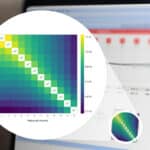Efficient, Reliable, Safe: SOUNDBRIDGE for Mixed Hearing Loss

VIBRANT SOUNDBRIDGE (VSB) ensures excellent and stable long-term hearing results in cases where conventional hearing aids and bone conduction systems reach their limits. In this article, you will learn about the specific advantages that VSB has over conventional bone conduction systems and hearing aids for people with mixed hearing loss.
Many people with mixed hearing loss cannot wear hearing aids either because it is not possible for medical reasons, or because hearing aids cannot provide them with sufficient amplification. VIBRANT SOUNDBRIDGE is able to solve both of these problems. Because it is implanted in the temporal bone, it bypasses any pathologies in the auditory canal. Only a small, lightweight audio processor sits externally on the head. The direct coupling of the transducer to the round window membrane means that the entire amplification power can be used to compensate for inner ear hearing loss, without needing to consider the conductive part of hearing loss.
More Powerful Than Hearing Aids
A study from Japan compared the objective and subjective improvements between hearing aids and VIBRANT SOUNDBRIDGE.1 For this study, 23 people with mixed hearing loss were fitted with a hearing aid and underwent an audiometry exam before being implanted with SOUNDBRIDGE. These results were later compared with the postoperative outcomes (20 weeks after implantation). The findings of the study demonstrate that:
- in pure-tone audiometry, significantly better results were obtained with VSB in four out of six frequencies.
- with VSB, significantly better results were achieved in both the one-syllable test and the sentence test (WRS and SRT in quiet).
- with VSB, the SRT in noise showed a clear trend towards better results compared to a hearing aid.
- subjective perception (APHAB questionnaire) was significantly better with VSB.
Based on those very positive results, the authors conclude that VSB is superior to hearing aids in almost all respects in this patient group. In addition, they conclude that VSB is a safe treatment method because very few complications or adverse events occurred and there were no significant changes in residual hearing.
Advantages Over Bone Conduction Systems
In general, bone conduction systems provide very good results in cases of mixed hearing loss. However, if the proportion of sensorineural hearing loss is too great, they reach their limits. These manifest themselves in the form of poorer audiological results as well as acoustic feedback and distortion.
Here too, VIBRANT SOUNDBRIDGE offers enormous advantages. Direct stimulation of the round window enables VSB to deliver maximum power to the cochlea without distortion. The spatial separation of transducer and microphones minimizes the risk of feedback. In addition to this—and a very important factor—is wearing comfort. SOUNDBRIDGE sits under intact skin. This is not the case, for example, with percutaneous, bone-anchored systems, which use a titanium screw that penetrates the skin.
A German study compared the audiological results of bone-anchored systems (BAHA) with those of VSB (coupled to the round window).2 Analysis of the data showed that the SOUNDBRIDGE group achieved better results both in quiet and in noise. A value of 35 dB HL was found to be the decisive criterion for the PTA4 bone conduction threshold. Recipients with better thresholds still achieved adequate speech understanding using the bone-anchored system. In contrast, recipients with more severe hearing loss showed significant differences: If the hearing thresholds were below 35 dB HL, the SOUNDBRIDGE users performed significantly better.
Long-Term Reliable Results
Safety and stable hearing success in the long-term are crucial requirements for implantation. A recently published study from Austria looked at long-term data from 46 VSB recipients.3 For this, a group with long-term data (more than 12 months) and one with short-term data (less than 12 months) was formed.
A comparison of the results from the two groups showed no significant differences in either language tests or functional gain. Changes in residual hearing also presented little difference. From these findings, it can be concluded that VSB provides stable audiological results in the long term, and is also a very safe treatment method.
The Only Implant System of its Kind
To conclude, we would like to briefly summarize the key findings from the studies discussed above. The studies show the advantages VIBRANT SOUNDBRIDGE has over not only hearing aids but also over bone conduction systems. SOUNDBRIDGE delivers better hearing outcomes that remain stable in the long term and can also increase subjective patient satisfaction. The data show why so many professionals recognize VIBRANT SOUNDBRIDGE—along with its active, transcutaneous technology—as the world’s most advanced middle ear implant system for conductive and mixed hearing loss.
Interested in VIBRANT SOUNDBRIDGE?
Would you like to perform SOUNDBRIDGE implantations in your clinic? Or do you simply want to learn more about this unique middle ear implant system? Get in touch with us.
Subscribe & Share
Take a look at our articles about the Minimal Reporting Standards for Active Middle Ear Implants and SAMBA 2, our newest audio processor for VIBRANT SOUNDBRIDGE.
Interested in more articles written specifically for ENT professionals about hearing implants? Subscribe to the MED-EL Professionals Blog now and receive regular updates from MED-EL directly in your inbox.
References
- Iwasaki et al., Round Window Application of an Active Middle Ear Implant: A Comparison with Hearing Aid Usage in Japan, Otol Neurotol, 6 (2017) 145-151. DOI: 10.1097/MAO.0000000000001438
- Mojallal et al., Retrospective Audiological Analysis of Bone Conduction versus Round Window Vibratory Stimulation in Patients with Mixed Hearing Loss, Int J Audiol, 6 (2015) 391-400. DOI: 10.3109/14992027.2014.986690
- G. M. Sprinzl et al., Long‐Term Stability and Safety of the Soundbridge Coupled to the Round Window, Laryngoscope, Nov 2020. DOI: 10.1002/lary.29269
CTA Form Success Message
Send us a message
Field is required
John Doe
Field is required
name@mail.com
Field is required
What do you think?



